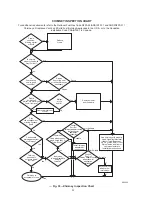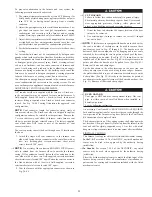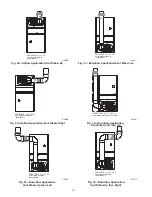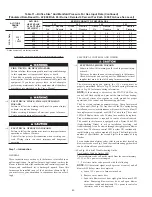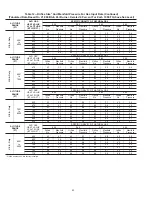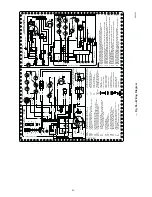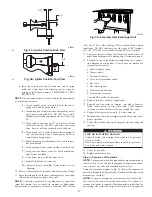
a. Place thermometers in return and supply ducts as close to
furnace as possible. Be sure thermometers do not see
radiant heat from heat exchangers. Radiant heat affects
temperature rise readings. This practice is particularly
important with straight-run ducts.
b. When thermometer readings stabilize, subtract return-air
temperature from supply-air temperature to determine air
temperature rise.
NOTE:
Blower access door must be installed for proper tempera-
ture rise measurement.
NOTE:
If the temperature rise is outside this range, first check:
1.) Gas input for heating operation.
2.) Derate for altitude if applicable.
3.) Return and supply ducts for excessive restrictions causing static
pressures greater than 0.50-in. wc.
4.)Dirty filter.
ELECTRICAL SHOCK HAZARD
Failure to follow this warning could result in personal injury
or death.
Disconnect 115-v electrical power before changing speed tap.
c. Adjust air temperature rise by adjusting blower speed.
Increase blower speed to reduce temperature rise. Decrease
blower speed to increase temperature rise.
d. Turn thermostat down below room temperature and re-
move blower access door.
e. To change motor speed selection for heating, remove
blower motor lead from control HEAT terminal (See Fig.
24.) Select desired blower motor speed lead from one of the
other terminals and relocate it to the HEAT terminal (See
Table 9 for lead color identification). Reconnect original
lead to SPARE terminal.
f. Repeat steps a through e.
g. When correct input rate and temperature rise is achieved,
turn gas valve ON/OFF switch to OFF.
h. Remove manometer or similar device from gas valve.
i. Reinstall manifold pressure tap plug in gas valve.
FIRE HAZARD
Leaking gas could be ignited and cause fire, explosion,
personal injury, property damage or death.
Reinstall manifold pressure tap plug in gas valve to prevent
gas leak.
j. Reinstall blower access door if removed.
k. Turn gas valve ON/OFF switch to ON.
FURNACE OVERHEATING HAZARD
Failure to properly set temperature rise may cause excessive
furnace temperatures and shorten furnace life.
Recheck temperature rise. It must be within limits specified
on the rating plate. Recommended operation is at the mid-
point of rise range or slightly above
6. Set thermostat heat anticipator.
a. Mechanical thermostat—Set thermostat heat anticipator to
match the amp draw of the electrical components in the
R-W circuit. Accurate amp draw readings can be obtained
at the wires normally connected to thermostat subbase
terminals, R and W. The thermostat anticipator should
NOT be in the circuit while measuring current.
(1.) Remove thermostat from subbase or from wall.
(2.) Connect an amp meter as shown in Fig. 54 across the
R and W subbase terminals or R and W wires at wall.
(3.) Record amp draw across terminals when furnace is in
heating and after blower starts.
(4.) Set heat anticipator on thermostat per thermostat
instructions and install on subbase or wall.
b. Electronic thermostat: Set cycle rate for 4 cycles per hr.
7. Adjust blower off delay
The blower off delay has 4 adjustable settings from 90 sec to
180 sec. The blower off delay jumpers are located on the
furnace control board. (See Fig. 24.)
To change the blower off delay setting, move the jumper from
one set of pins on the control to the pins used for the selected
blower off delay. Factory off delay setting is 120 sec.
8. Set airflow CFM for cooling
Select the desired blower motor speed lead for cooling
airflow. See Table 5-Air Delivery-CFM (With Filter). See
Table 9 for lead color identification.
Step 4—Check Safety Controls
The flame sensor, gas valve, and pressure switch were all checked
in the Start-up procedure section as part of normal operation.
1. Check Main Limit Switch(es)
This control shuts off combustion control system and ener-
gizes air-circulating blower motor, if furnace overheats. By
using this method to check limit control, it can be established
that limit is functioning properly and will operate if there is a
restricted duct system or motor failure. If limit control does
not function during this test, cause must be determined and
corrected.
a. Run furnace for at least 5 minutes.
b. Gradually block off return air with a piece of cardboard or
sheet metal until the limit trips.
Fig. 53—Orifice Hole
A93059
BURNER
ORIFICE
Table 9—Speed Selection
COLOR
SPEED
AS SHIPPED
White
Common
BLW
Black
High
COOL
Yellow†
Med-High
SPARE
Blue
Med-Low
HEAT
Red
Low*
SPARE
* Continuous-blower speed-as shipped default
† Not available on 1/5 HP motors.
36
→
→
→







